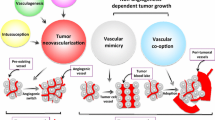Abstract
Most solid-tumor malignancies remain incurable. Novel agents that target and counteract biologic mechanisms are now being developed. It is hoped that these drugs will allow for more effective, less toxic cancer treatments and long-term maintenance approaches. One important class of agents functions by an anti-angiogenic mechanism, targeting the blood vessel supply of the tumor and inhibiting tumor growth. Several principles are common to these new agents. First, because many of these agents are growth-inhibiting molecules that work exclusively against the tumor vasculature, single agents will have little effect on tumor size in advanced disease. Second, because these agents are relatively non-toxic, they are unlikely to induce the side effects associated with chemotherapy. Because endothelial cells seldom divide in a human host, anti-angiogenic compounds are expected to produce little toxicity. Third, most of these agents work synergistically with chemotherapy and/or radiotherapy. Ironically, combining these relatively non-toxic agents with chemotherapy often produces the toxicities usually associated with anticancer regimens. Anti-angiogenic agents might ultimately be studied in minimal disease. Clinical studies must demonstrate that these agents affect tumor vasculature, and phase I trials should include built-in surrogate endpoints. This article defines the general principles of anti-angiogenic drug action and explains how these principles have been used to design a phase I trial of human endostatin.
Similar content being viewed by others
References and Recommended Reading
Fidler IJ, Ellis L: The implications of angiogenesis for the biology and therapy of cancer metastasis. Cell 1994, 79:185–188.
Fidler IJ: Cancer biology: invasion and metastasis. In Clinical Oncology, edn 2. Edited by Abeloff MD, Armitage JO, Lichter AS, Niederhuber JE. Kent, UK: Churchill Livingstone; 2000:29–53. Outlines the process of metastasis as a progression of steps, each of which may be targeted to prevent tumor growth and metastasis.
Folkman J: Angiogenesis in cancer, vascular, rheumatoid and other disease. Nat Med 1995, 1:27–31. A review describing endogenous regulators of angiogenesis, thus introducing a new paradigm in tumorigenesis and possible targets to prevent tumor progression.
Twardowski P, Gradishar WJ: Clinical trials of antiangiogenic agents. Curr Opin Oncol 1997, 9:584–589.
Eisenhauer EA: Phase I and II trials of novel anti-cancer agents: endpoints, efficacy and existentialism. Ann Oncol 1998, 9:1047–1052. This subsequently published lecture outlines critical issues involved in drug development and trial design of cytostatic versus cytotoxic drugs.
McCawley LJ, Matrisian LM: Matrix metalloproteinases: multifunctional contributors to tumor progression. Mol Med Today 2000, 6:149–156.
Herbst RS, Takeuchi H, Teicher BA: Paclitaxel/carboplatin administration along with antiangiogenic therapy in non-small-cell lung and breast carcinoma models. Cancer Chemother Pharmacol 1998, 41:497–504.
Herbst RS, Tran HT, Madden T, et al.: Phase I study of the angiogenesis inhibitor TNP-470 in combination with paclitaxel in patients with solid tumors: a dose finding, pharmacokinetic, and efficacy analysis [abstract]. Proc ASCO 2000, 19:707.
Lewis NL, Scher R, Weiner LM, et al.: Phase I and pharmacokinetic study of irinotecan in combination with raltitrexed [abstract]. Proc ASCO 2000, 19:757.
DeVore R, Fehrenbacher L, Herbst R, et al.: A randomized phase II trial comparing rhuMAb VEGF (recombinant humanized monoclonal antibody to vascular endothelial cell growth factor) plus carboplatin/paclitaxel chemotherapy (CRx) to CRx alone in patients with stage IIIb/IV NSCLC [abstract]. Proc ASCO 2000, 19:1896.
O’Reilly MS, Boehm T, Shing Y, et al.: Endostatin: an endogenous inhibitor of angiogenesis and tumor growth. Cell 1997, 88:277–285. The authors identify and characterize endostatin as an endogenous angiogenesis inhibitor and demonstrate its ability to inhibit endothelial cell proliferation and the induction of tumor dormancy. Endostatin exhibited no toxicity as seen in mouse models.
Boehm T, Folkman J, Browder T, O’Reilly MS: Antiangiogenic therapy of experimental cancer does not induce acquired drug resistance [see comments]. Nature 1997, 390:404–407. The authors describe the benefits of anti-angiogenic therapy, such as the elimination of drug resistance and the induction of prolonged tumor dormancy following repeated cycles of therapy.
Boehm T, O’Reilly MS, Keough K, et al.: Zinc-binding of endostatin is essential for its antiangiogenic activity. Biochem Biophys Res Commun 1998, 252:190–194.
Ding YH, Javaherian K, Lo KM, et al.: Zinc-dependent dimers observed in crystals of human endostatin. Proc Natl Acad Sci U S A 1998, 95:10443–10448.
O’Reilly MS, Holmgren L, Chen C, Folkman J: Angiostatin induces and sustains dormancy of human primary tumors in mice. Nat Med 1996, 2:689–692.
Kerbel RS: A cancer therapy resistant to resistance. Nature 1997, 390:335–336. A review that describes the effects of anti-antigenic drugs, either directly on endothelial cells or indirectly by acting on growth or survival factors.
Tomaszewski JE, Schweikart KM, Covey JM, et al.: Mouse pharmacokinetics and pharmacological basis for drug development of recombinant human endostatin. Proc Am Assoc Adv Sci, 1999.
Sim BK, Fogler WE, Zhou XH: Potent inhibition of experimental metastases and primary tumors by recombinant human endostatin that is suitable for human use. Proc Am Assoc Cancer Res, 1999.
Delorme S, Knopp MV: Non-invasive vascular imaging: assessing tumour vascularity. Eur Radiol 1998, 8:517–527.
Takahashi Y, Cleary KR, Mai M, et al.: Significance of vessel count and vascular endothelial growth factor and its receptor (KDR) in intestinal-type gastric cancer. Clin Cancer Res 1996, 2:1679–1684.
Koenig M, Klotz E, Luka B, et al.: Perfusion CT of the brain: diagnostic approach for early detection of ischemic stroke. Radiology 1998, 209:85–93.
Weissleder R, Cheng HC, Marecos E, et al.: Non-invasive in vivo mapping of tumour vascular and interstitial volume fractions. Eur J Cancer 1998, 34:1448–1454.
Cenic A, Nabavi DG, Craen RA, et al.: Dynamic CT measurement of cerebral blood flow: a validation study. Am J Neuroradiol 1999, 20:63–73.
Author information
Authors and Affiliations
Rights and permissions
About this article
Cite this article
Herbst, R.S., Lee, A.T., Tran, H.T. et al. Clinical studies of angiogenesis inhibitors: The university of texas md anderson center trial of human endostatin. Curr Oncol Rep 3, 131–140 (2001). https://doi.org/10.1007/s11912-001-0013-8
Issue Date:
DOI: https://doi.org/10.1007/s11912-001-0013-8




